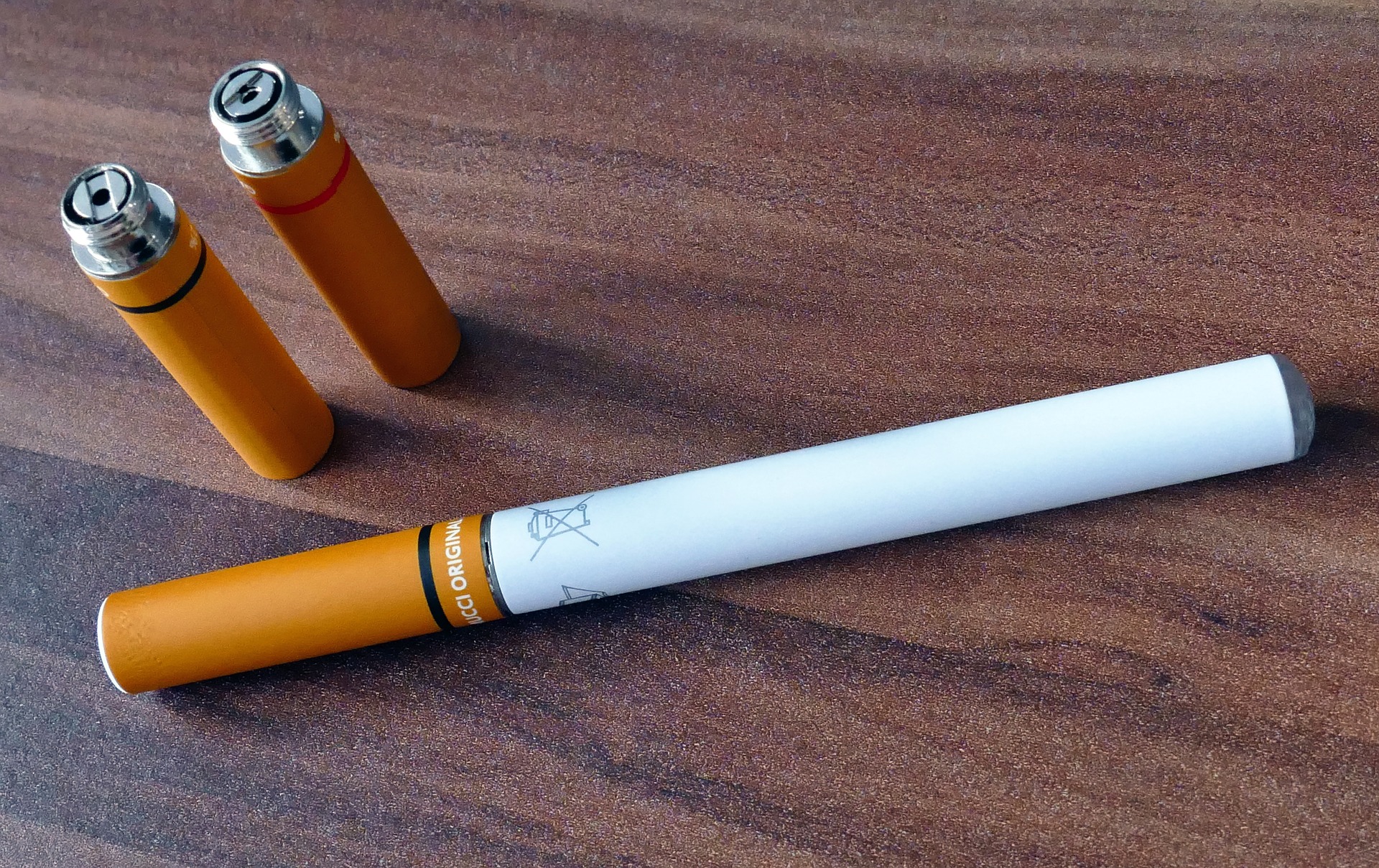E-Cigarettes – Are They A Tool To Quit Smoking?
The iconic image of coffee and cigarettes is subtly being replaced by coffee and vaping. Welcome to the 21st century. Read on to figure out if e-cigarettes can help quit smoking.

Quitting smoking is hard. Traditional methods to help you quit smoking include:
- Nicotine Replacement Therapies (NRT): gum, lozenges, inhalers, mouth sprays and patches
- Behavioural Therapies
- Prescription Products: buproprion and varenicline
- (Cold Turkey!)
Note: Nicotine Replacement Therapies (NRT) can be bought without a prescription from pharmacies
Although vaping with nicotine is used by many to help quit smoking, it is not officially recognized as a nicotine replacement therapy (in Canada or the USA). Some major vaping brands such as Juul also market themselves as an ‘alternative to cigarettes’.
In this article, we will discuss the use of vaping with nicotine as a way to quit smoking. This article is not about whether or not vaping is a good alternative to smoking. Read on!
- What is Vaping?
- What is the Difference between an E-cigarette and other Vaping Devices?
- What is the Difference Between an E-cigarettes and a Regular Cigarette?
- What Ingredients Are in Vaping Devices?
- How Do E-Cigarettes Help You Quit Smoking?
- Do E-Cigarettes Really Work to Help Quit Smoking?
- What Are Some of the Safety Concerns with Vaping Nicotine?
- Bottom Line
What Is Vaping?
Vaping is the inhaling and exhaling of an aerosol from the mouthpiece of a vaping device. Vaping devices heat a liquid (often called e-liquid or e-juice) into a vapour, which then becomes an aerosol[1]. Most vaping devices are rechargeable by battery and newer ones by USB. They also contain different parts[2]:
- Mouthpiece
- Battery
- Cartridge for containing the e-liquid/e-juice
- Heating component for the device
Vaping: inhaling and exhaling an aerosol
Vaping Device: heat liquids into a vapour which then turns into an aerosol
Aerosol: liquid droplets suspended in a gas
What is the Difference Between an E-cigarette and other Vaping Devices?
Often, the terms e-cigarette (“e-cig”) and “vape” are used interchangeably. Initially, an e-cigarette was a type of vaping device that looked like a cigarette and usually contained nicotine. It still exists but now an e-cigarette means many different types of vaping devices that could also contain nicotine. For the rest of this article we will use the term e-cigarette to mean any vaping device that contains nicotine. Here are some common devices[3]:
E-cigarettes
Vape Pens
MODS 
(Mechanical Modified Nicotine Delivery Systems)
Juul 
In Canada, the use of e-cigarettes has increased significantly since 2015. By 2017, at least 15% of Canadians (4.6 million) have tried an e-cigarette[4]. This trend has also spread widely in the United States, where at least 27.1% of adolescents have tried an e-cigarette at least once[5].
The term ‘e-cigarette’ can also include other devices such as “mods”, “vape pens” “vapes”, “electronic nicotine delivery system” and “Juul”
What is the Difference Between an E-cigarettes and a Regular Cigarette?
There are three major differences between smoking cigarettes and vaping with nicotine[6]:
- Vaping does not involve burning
- There is no tobacco in vaping nicotine
- Vaping does not produce smoke
What Ingredients are Used in Vaping Devices?
The e-liquid is the solution that becomes an aerosol in a vaping device. It has an ingredient list that is often vague, containing terms like “natural oils, extracts and flavour” making it challenging to really dig into the specific ingredients. E-liquids usually contain a variation of the following[5]:
- Nicotine (found in varying concentrations)
- Propylene glycol (acts as a solvent for nicotine and the other flavouring chemicals)
- Glycerol (acts as a solvent for nicotine and the other flavouring chemicals)
- Benzoic Acid
- Flavourings (a little ambiguous but is likely referring to both the natural and synthetic ingredients)
Sometimes the aerosol (that is in inhaled and exhaled) may end up containing different substances due to the heating reaction that takes place, creating different chemicals. Some aerosols have also been found to have heavy metals such as nickel, tin and lead and flavouring agents such as diacetyl which as been linked to lung cancer[5].
There over 7000 unique flavours that exist, such as bubble gum, belgian waffle, strawberry daiquiri (users can also create their own custom flavours) adding to the various ingredients!
How Do E-Cigarettes Help You Quit Smoking?
The two main ways e-cigarettes help with smoking is they prevent nicotine withdrawal effects and help to mimic smoking behaviour:
- Prevent withdrawal effects from nicotine (physiological)
Addiction to cigarettes or other tobacco-containing products is mainly due to nicotine[7]. Nicotine acts as both as stimulant and as a sedative and can produce feelings of pleasure and relaxation through increased dopamine levels in the brain. The increased dopamine causes the addiction to cigarettes. If you try to quit smoking suddenly, withdrawal effects are common such as: cravings, anxiety, anger and depression (as the brain tries to re-balance dopamine levels). These side-effects make it hard to quit smoking so it’s common to start smoking again[8]. Using a product to slowly reduce nicotine levels may help someone quick smoking.
- Mimic smoking behaviour (psychological)
Vaping mimics some of the behavioural conditioning from smoking, such as inhaling and exhaling, holding a cigarette-like device and the hand-to-mouth ritual. Using a device like an e-cigarette can help imitate the habitual mental conditioning that comes with smoking cigarettes[9].

Do E-Cigarettes Really Work to Help Quit Smoking?
Basically, we don’t know. The evidence on the efficacy of e-cigarettes as smoking cessation product (something used to help stop smoking) is currently mixed.
Some studies have shown it to be better than trying to quit cold turkey. While other studies find e-cigarettes less effective than nicotine replacement therapies (patches, gums, lozenges, inhalers). There is some evidence to suggest that e-cigarettes may be more effective than other nicotine replacement products when used in combination with behavioral therapy[10].
According to Health Canada, replacing cigarette smoking with vaping reduces the amount of harmful chemicals you breathe in and may help those that can’t quit on their own[6]. It may have some short-term health improvements because it has less cancer-causing chemicals compared to tobacco found in cigarettes.
It is important to note that E-cigarettes have only been in the market for about a decade so there are no long-term studies. At this point, nicotine replacement therapies (NRT) are currently first line therapy for smoking cessation according to clinical practice guidelines used in Canada[11]. E-cigarettes are not approved nicotine replacement products in either Canada or the United States[10].
What Are Some of the Safety Concerns with Vaping Nicotine?
Mouth and throat irritation are the most commonly reported side effects of vaping. This might be attributable to the propylene glycol used to dissolve some of the active compounds[12]. The long-term effects of inhaled propylene glycol and glycerol are not clear but they are known to create carcinogens. In fact, many of the flavourings and additives used might be toxic to the body when inhaled but need to be further studied. Two leading brands of e-cigarettes were found to contain known carcinogens (nitrosamines) and a toxic compound found in antifreeze (diethylene glycol) when further studied[10].
There are still side effects from nicotine use [13] such as:
- Nicotine dependence
- Nicotine addiction in those who would not have started using nicotine otherwise (especially early adolescents)
- Memory and concentration problems
- Cognitive problems (especially in teens)
- Liquid nicotine is poisonous to young children if accidentally swallowed (make sure vaping liquid is child resistant)
There is a current concern with vaping in under-age youth. Over the past few years, the highest increase has been among youths (16-19 years old) which has increased by 74%[4]. The flavours can actually facilitate nicotine addiction because it masks the bad smell and taste, making it more pleasurable to use[4][5].
Bottom Line
Vaping is still relatively new and there needs to be longer-term studies to really determine how effective and safe it is. It might be helpful in short-term situation to those who are serious about quitting but haven’t had success by themselves, experience heavy nicotine withdrawal symptoms or experience side effects to other proven alternatives. As it stands, the evidence is mixed as a whether vaping with nicotine is an effective way to quit smoking. One of the reasons it is thought to be safer than cigarettes is due to the fact it does not contain tobacco; however, there are still some major safety concerns and many of the ingredients (especially when inhaled) are not known.
Authors:
Prabhpaul Dhami, Ajay Passi, Gurpal Gill, BSc. Pharm Candidates
Faculty of Pharmacy and Pharmaceutical Sciences
University of Alberta
Corresponding Author:
Aliya Kassamali, B.Sc.Pharm, PharmD
Edited and Reviewed by the Health Aisle Team
Last Updated: September 30, 2019
References:
1. Health Canada. (2018). About Vaping. Retrieved from: https://www.canada.ca/en/health-canada/services/smoking-tobacco/vaping.html
2. Center on Addiction. (2018). What is Vaping? Retrieved from: https://www.centeronaddiction.org/e-cigarettes/recreational-vaping/what-vaping
3. Center on Addiction. (2018). What Parents Should Know About the Different Vaping Devices. Retrieved from: https://www.centeronaddiction.org/e-cigarettes/recreational-vaping/what-parents-should-know-about-different-vaping-devices
4. Reid JL, Hammond D, Tariq U, Burkhalter R, Rynard VL, Douglas O. Tobacco Use in Canada: Patterns and Trends, 2019 Edition. Waterloo, ON: Propel Centre for Population Health Impact, University of Waterloo
5. U.S. Department of Health and Human Services. E-Cigarette Use Among Youth and Young Adults. A Report of the Surgeon General. Atlanta, GA: U.S. Department of Health and Human Services, Centers for Disease Control and Prevention, National Center for Chronic Disease Prevention and Health Promotion, Office on Smoking and Health, 2016
6. Health Canada. (2019). Vaping and Quitting Smoking. Retrieved from: https://www.canada.ca/en/health-canada/services/smoking-tobacco/vaping/smokers.html
7. Benowitz N. L. (2010). Nicotine addiction. The New England journal of medicine, 362(24), 2295–2303. doi:10.1056/NEJMra0809890
8. Benowitz, N. L., & Henningfield, J. E. (2013). Reducing the nicotine content to make cigarettes less addictive. Tobacco control, 22 Suppl 1(Suppl 1), i14–i17. doi:10.1136/tobaccocontrol-2012-050860
9. Petrasko, K. and Bains, M. (2013). Smoking Cessation. In Therapeutic Choices for Minor Ailments (pp. 51-68). Canadian Pharmacists Association.
10. DynaMed (2018). Nicotine replacement therapy for tobacco cessation. Ipswich (MA): EBSCO Information Services. Retrieved Aug 10, 2019, from https://www.dynamed.com/management/nicotine-replacement-therapy-for-tobacco-cessation/
11. Fiore MC, Jaén CR, Baker TB, et al. (2008) Treating Tobacco Use and Dependence: 2008 Update. Clinical Practice Guideline. Rockville, MD: U.S. Department of Health and Human Services. Public Health Service.
12. Hartmann-Boyce, J., McRobbie, H., Bullen, C., Begh, R., Stead, L. F., & Hajek, P. (2016). Electronic cigarettes for smoking cessation. The Cochrane database of systematic reviews, 9(9), CD010216. doi:10.1002/14651858.CD010216.pub3
13. Health Canada. (2019). Risks of Vaping. Retrieved from: https://www.canada.ca/en/health-canada/services/smoking-tobacco/vaping/risks.html#a1






Leave a Comment